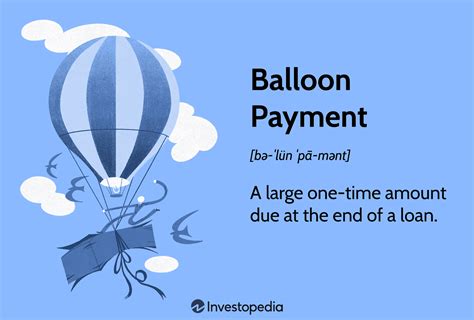Understanding Balloon Loans: The Basics
Balloon loans, also known as balloon mortgages, are a type of loan that features a relatively small monthly payment for a fixed period, followed by a “balloon” payment that is significantly larger than the previous payments. The balloon payment typically represents the remaining principal balance of the loan, which must be paid in full upon maturity.

Key Characteristics of Balloon Loans:
- Relatively low monthly payments during the initial loan term
- A substantial balloon payment at the end of the loan term, typically equal to the remaining principal balance
- Loan terms ranging from 5 to 30 years, commonly 10 to 15 years
- Interest rates may be fixed or adjustable
Types of Balloon Loans
1. Adjustable-Rate Balloon Loans:
The interest rate on these loans can fluctuate based on market conditions, leading to changes in monthly payments over time.
2. Fixed-Rate Balloon Loans:
The interest rate on these loans remains constant throughout the loan term, providing stability in monthly payments.
Advantages and Disadvantages of Balloon Loans
Advantages:
- Lower monthly payments during the initial loan term, freeing up cash flow for other expenses
- Potential for investment opportunities with the savings from lower payments
- Can be used to finance larger purchases, such as a home or business venture
Disadvantages:
- The large balloon payment can be difficult to manage at the end of the loan term, potentially forcing homeowners to sell their property or refinance the loan
- Interest rates may be higher than traditional fixed-rate mortgages
- Qualification requirements can be more stringent than for other loan types
Balloon Loans vs. Traditional Mortgages
| Feature | Balloon Loan | Traditional Mortgage |
|---|---|---|
| Monthly Payments | Lower in initial years, balloon payment at maturity | Consistent throughout loan term |
| Balloon Payment | Required at end of loan term | Not required |
| Loan Term | Typically shorter (10-15 years) | Longer (15-30 years) |
| Interest Rates | May be higher | Typically lower |
| Qualification | More stringent | Less stringent |
Applications and Suitability of Balloon Loans
Balloon loans can be beneficial in certain situations, such as:
- Financing short-term projects or investments
- Purchasing a home when down payment savings are limited
- Speculating on real estate appreciation
However, it’s crucial to carefully consider the potential risks and responsibilities associated with balloon loans before choosing this financing option.
Steps to Consider When Getting a Balloon Loan
- Assess Financial Situation: Determine if you can afford the balloon payment at the end of the loan term.
- Explore Alternative Options: Consider other types of loans, such as traditional mortgages or adjustable-rate mortgages.
- Negotiate Loan Terms: Discuss loan amount, interest rate, and repayment schedule with a lender.
- Budget and Plan: Create a financial plan that includes saving for the balloon payment.
- Seek Professional Advice: Consult with a financial advisor or mortgage broker to ensure the loan is right for you.
Future Trends and Improvements in Balloon Loans
The use of balloon loans may evolve in the following ways:
- Increased Regulatory Oversight: Governments and financial institutions may implement stricter regulations to protect borrowers from potential risks.
- Innovative Repayment Options: Lenders may offer flexible repayment plans, such as payment holidays or interest-only periods, to assist borrowers in managing the balloon payment.
- Digitalization and Accessibility: Technology can enhance the accessibility and transparency of balloon loan information, enabling borrowers to make informed decisions.
By staying informed about the advantages, disadvantages, and potential applications of balloon loans, individuals can harness this financial tool effectively to achieve their financial goals.



